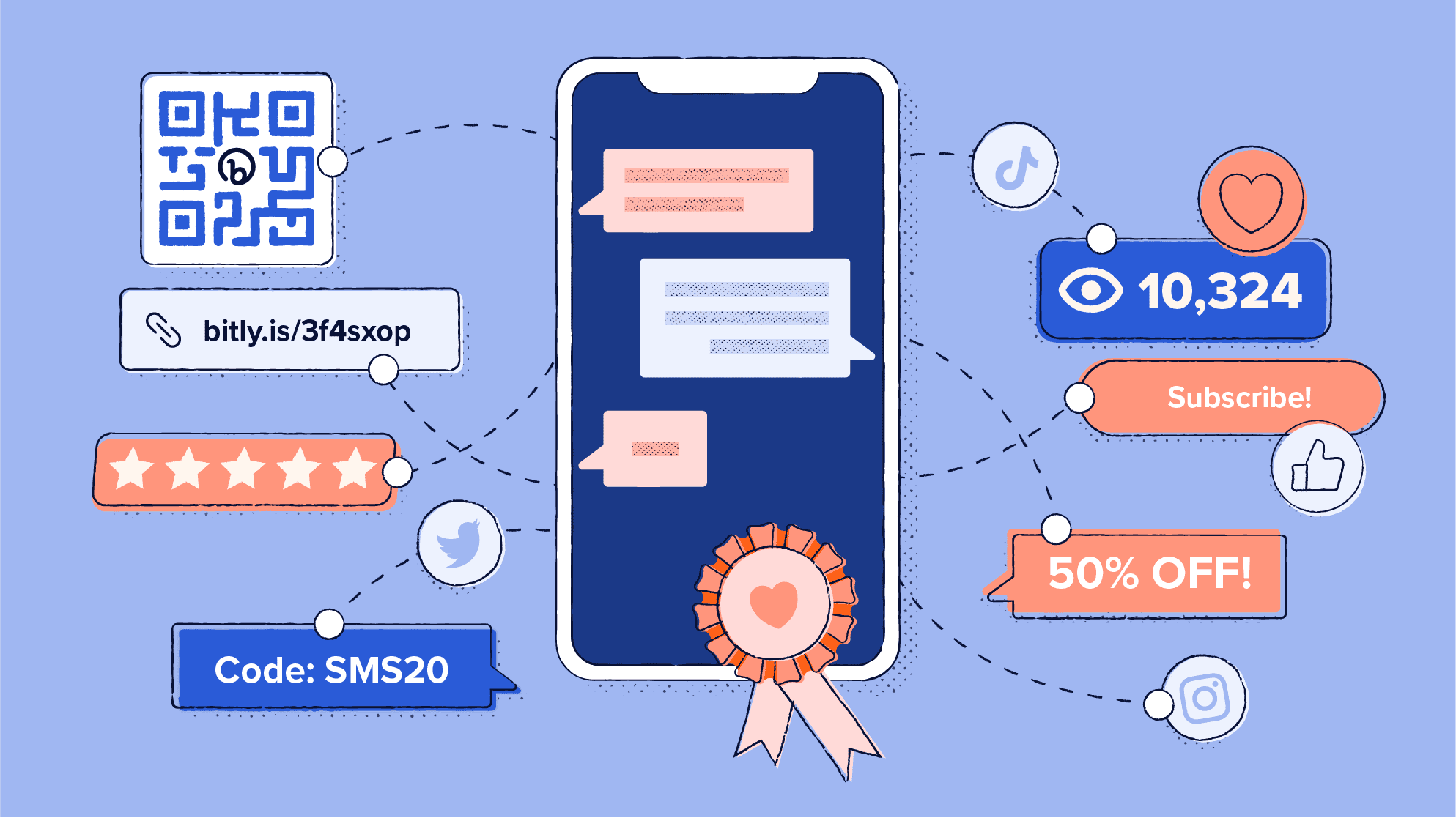
With 160 characters or less, you can turn customers into fans, increase sales, and achieve success. Learn SMS best practices from experts and take advantage of the immediate marketing tool consumers hold in their hands. We cover 74 best practices, divided by category.
General SMS marketing best practices
SMS marketing best practices start with creating a strategy to achieve business goals. A strategic plan builds the foundation for all other SMS best practices. Also, think creatively about your SMS campaign options, including integrating with other channels. Above all, follow trade association and legal guidelines.
“To make SMS marketing work well for you, develop a strategic plan following best practices developed by experts,” recommends Raleigh Harbour, President of Bitly. “Otherwise, you’ll likely struggle and not reap the ROI that SMS can bring. It’s a powerful channel.”
According to CNET, people spend a third of their waking hours on their phones. These best practices will help you to reach them effectively.
Here’s a detailed look at general SMS best practices:
- Start with an SMS campaign strategy
Do the heavy lifting at the front end of the process. Start with a formal SMS marketing strategy and a written plan aligned with your overall marketing strategy. Once a plan is in place, SMS is an almost unbeatable marketing channel, says Barbara Casey, CEO of SMS marketing agency Mobile High 5.
“Want to be guaranteed your customer will see your content? No other channel delivers such a high level of eyeballs: 97% read rate, within 90 seconds,” says Casey. “And click-throughs on links are terrific. If you send an email, you get a 5% click-through rate and be happy. By contrast, if you send your offer in text, you can realize a 25% to 65% click-through depending on your value message.”

Barbara Casey, CEO of SMS marketing agency Mobile High 5.
- Use SMART goals for your SMS campaigns
Set goals that are specific, measurable, achievable, relevant, and timely. Define your key performance indicators (KPIs) and use them for analysis during and after your campaigns. This ensures you’re staying on track with your definition of success. - Explore all your options
“SMS is the most flexible marketing channel,” says Casey. “There are many ways to configure text advertising and campaigns; it works for almost any industry.” Options include sweepstakes, survey drip campaigns, and integrating social media with SMS campaigns to grow subscriber lists. - Follow trade association best practice guidelines
The ultimate overseers of SMS marketing in the United States are the Federal Communications Commission (FCC) and Federal Trade Commission (FTC). The FCC’s CAN-SPAM Act dictates that messages must be easily identifiable as ads, and it makes robotexts, or unwanted text messages, illegal. The Cellular Telecommunications Industry Association’s (CTIA) Messaging Principles and Best Practices publication provides additional guidance. The CTIA also reports non-compliant marketers to wireless carriers who may cut off accounts.
SMS compliance best practices
SMS marketers must comply with many regulations or risk significant penalties. It’s essential to follow best practices regarding opt-in rules and honoring opt-outs. Other best practices concern written consent, terms and conditions, timing, and identifying yourself.
Here are best practices to achieve maximum SMS compliance:
- Make sure you comply, because penalties are high
A Juniper Research report predicts businesses will send 3.5 trillion SMS messages in 2023. Along with that growth, oversight has grown as well. When the CTIA reports non-compliant SMS programs and providers, the wireless carriers can suspend the marketing program or shut down the sender’s operations.
You also may be fined, starting at $500 for every illegally sent message. For example, a company with 2,000 illegal contacts faces at least $1 million in fines. The penalties for violations deemed intentional triple to $1,500 each, so in the example, the fine for deliberate violation is $3 million. Damage fines have no cap, and businesses are responsible for every breach. As subscriber lists grow, so do the potential damages, often outpacing insurance coverage. - Be upfront
This advice comes from Caroline Clark, retention marketing manager at Clean Origin, purveyors of ethical, lab-grown diamonds. “Make sure your customers have clear opt-in and opt-out options,” she says. “Don’t be sneaky; make it obvious to obtain the right permission from your customers. It’s also a great idea to have two-level opt-in by sending a confirmation text after they initially sign up.”
She continues, “For SMS specifically, we have grown our subscribers from 0 to 13,000 in six months. We have seen incredible growth by offering an incentive to sign up (for example, a chance to win a pair of diamond stud earrings).”

Caroline Clark, retention marketing manager at Clean Origin.
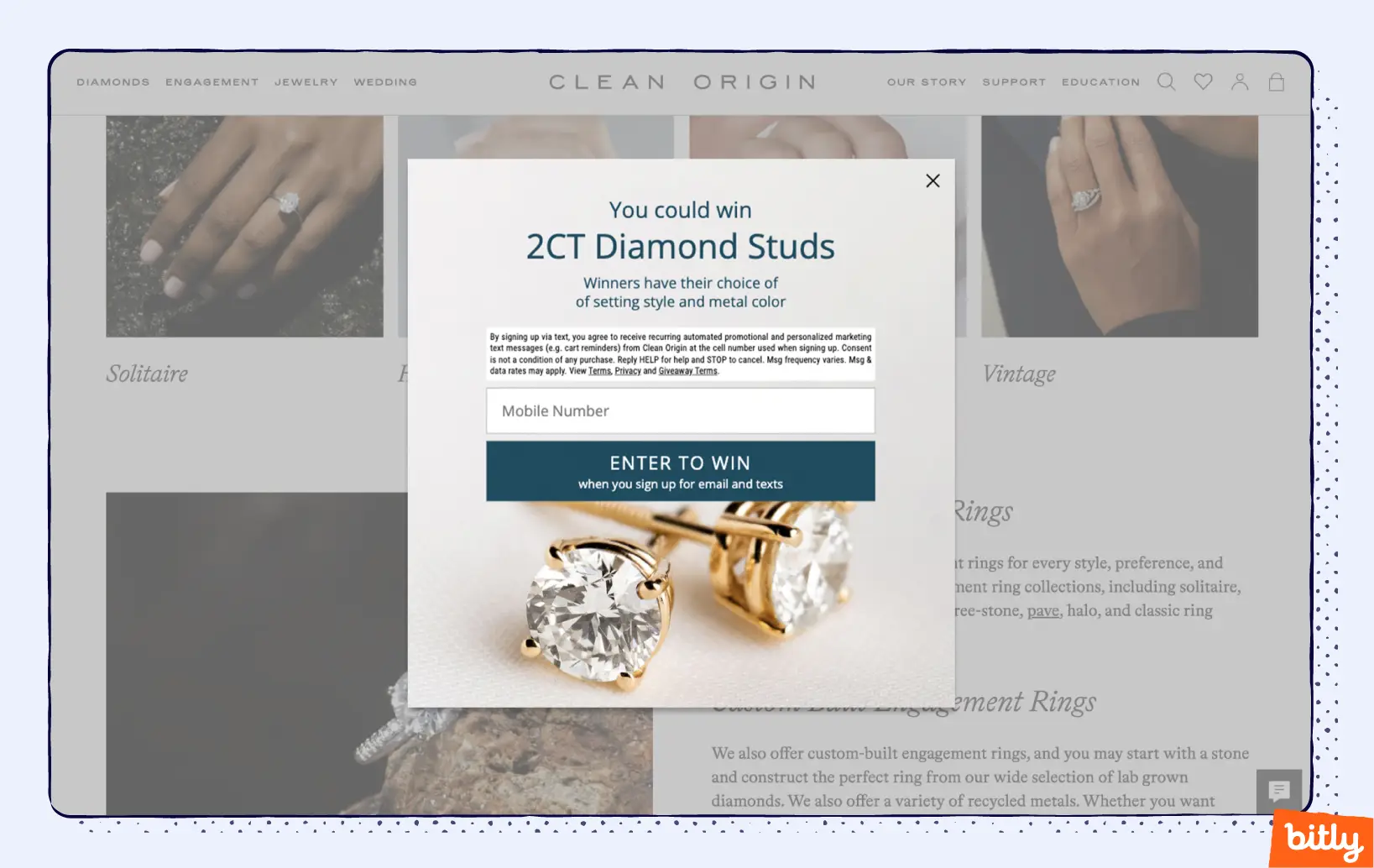
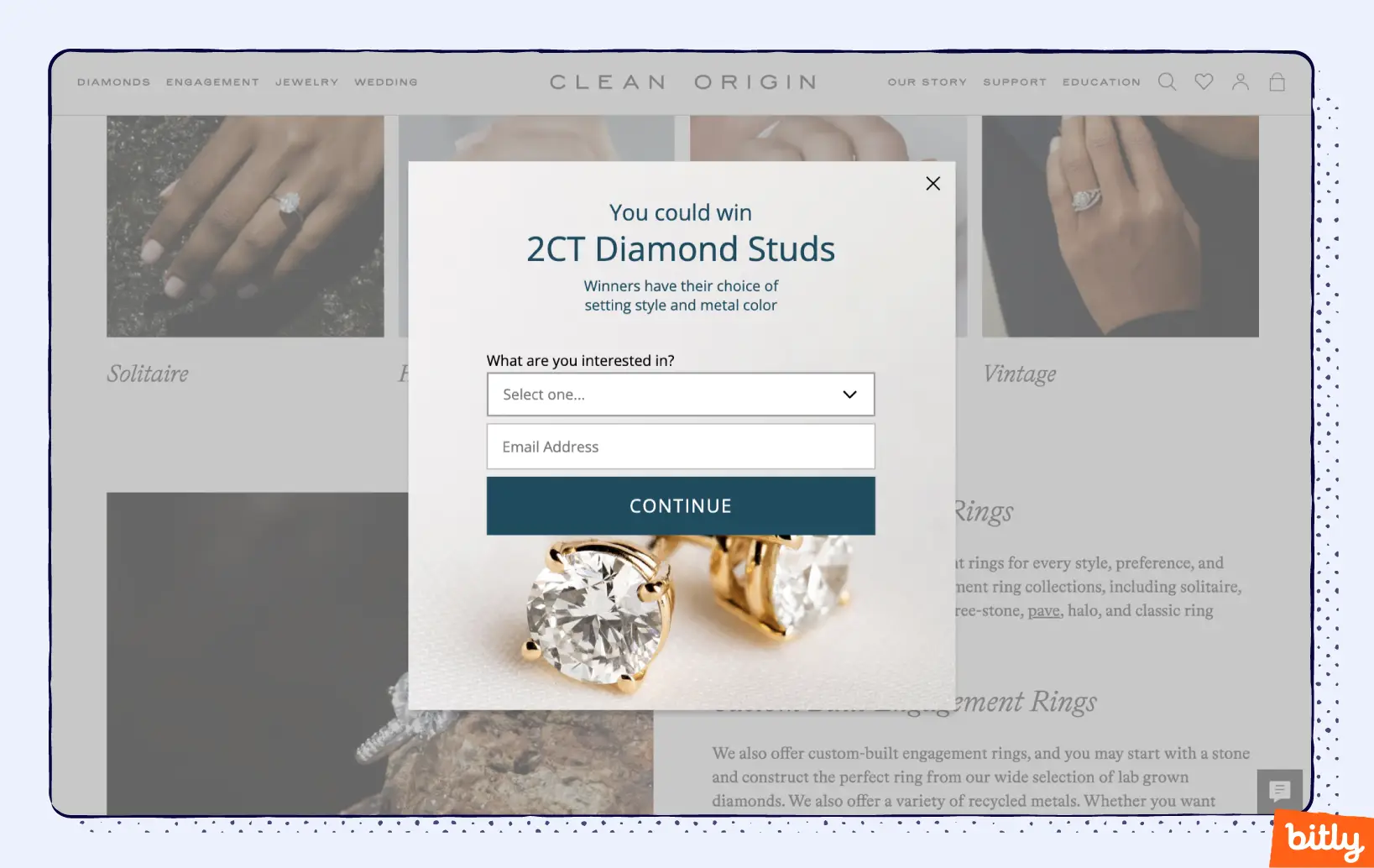

- Disclose program details at opt-in
You must include certain information wherever you provide a call to action (CTA) to opt into your SMS program. These details include: your business name, text message, data rate notices, a link to your terms and conditions, the types of messages recipients can expect, message cadence, privacy policy, and opt-out instructions. - Obtain written consent
You must get permission to text consumers marketing messages, usually with online consent forms. Explicitly state that enrollment means the subscriber agrees to receive text messages. - Clarify terms and conditions
Link to the full terms in the initial disclosure. Then, periodically remind your customers how to access the terms and conditions. Also, notify them of any changes. - Observe timing guidelines
The Cellular Telecommunications Industry Association (CTIA) dictates that you cannot text or call subscribers before 8 am or after 9 pm. - Give your business name in every text
You should always identify yourself for full transparency. - Make opt-outs easy
An essential piece of SMS compliance is the opt-out process. Make it clear and simple for subscribers to opt out. - Curb your language
The CTIA’s SHAFT rule (Sex, Hate, Alcohol, Firearms, and Tobacco) prohibits companies from sending content on those five topics. The rule also applies to all SMS promotions for your marketing program. However, companies that sell tobacco or alcohol can send texts for deals if they include an age verification system to ensure subscribers are of legal age. - Leave opt-outs alone
SMS marketing falls under the National Do Not Call Registry. Texting people on this list and subscribers who have opted out is illegal.
SMS data and testing best practices
Collecting and using data is an essential SMS best practice. You must understand your customers to build relationships and engage them successfully in campaigns. It’s vital to test different approaches until you find what yields the best results.
Here are details on SMS campaign analysis best practices:
- Test until you see what’s essential
This best practice comes from Teri Shern, co-founder of Conex Boxes, a shipping container company. “Post-marketing analysis, we realized customers don’t want to hear about new containers or general pricing lists—they prefer to receive that information via email. When a new campaign runs or we need to re-engage, we give them a reason to click through to our product and website with special pricing. It’s a good call to action, and SMS beats general marketing.”

Teri Shern, co-founder of Conex Boxes.
- Uncover your VIPs
“Based on our user analysis of purchasing frequency overall, purchases in recent months, and those who purchased a large amount overall, it was relatively easy to create a VIP customer segment, ” says Brian Lim, founder and CEO of INTO THE AM and iHeartRaves.

Brian Lim, founder and CEO of INTO THE AM and iHeartRaves.
Lim has been featured on Shark Tank and attributes his $30 million yearly income to shrewd marketing, particularly SMS campaigns. His target audiences tend to be in their late teens to twenties.
“We use phrases like ‘Early access!’ or ‘Just for you’ to excite our loyal customers,” Lim says. “These VIP customer texts consistently have higher click-through and conversion rates. VIP customers receive texts up to 24 hours before anyone else so they can have a first look at new products or sales. That way, we have time for additional campaign performance analysis and tweaks before the campaign moves on to a larger customer segment.”
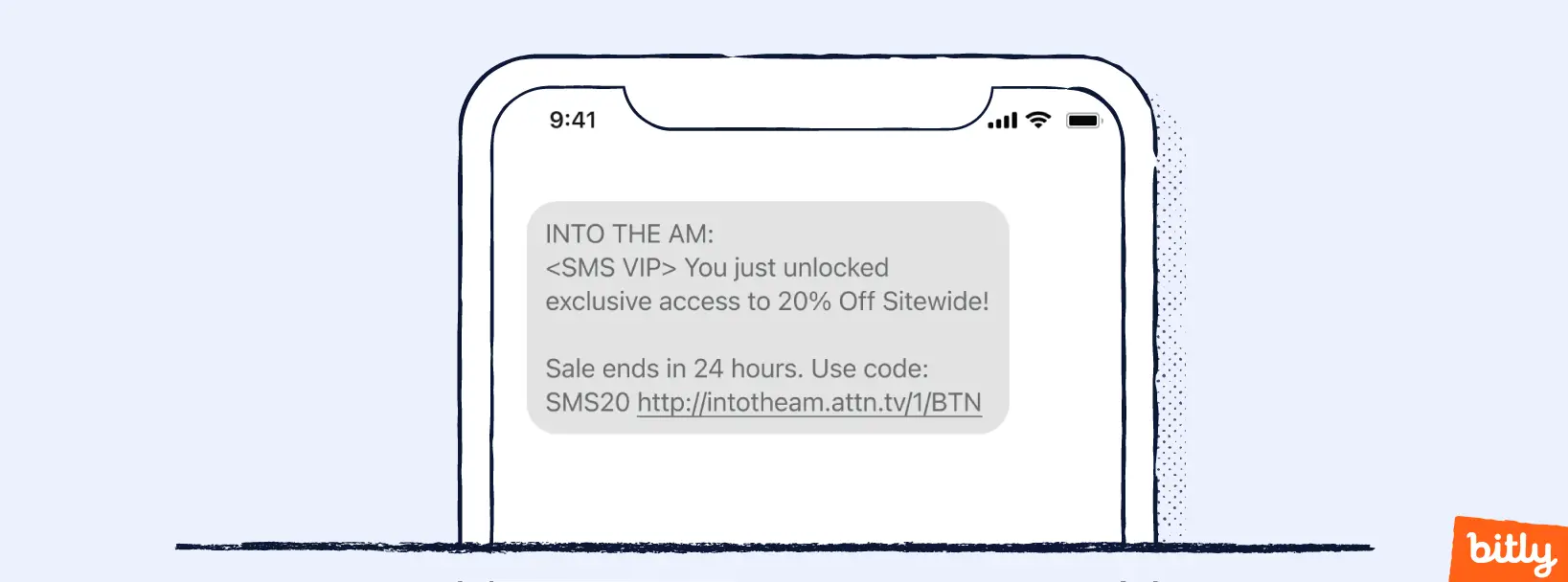
- Calculate your click-through rate (CTR)
The CTR is clicks divided by sends. First, track the number of unique clicks from your SMS campaign with a link management tool. Then, divide the number of clicks by the number of texts sent. Third, multiply by 100 to convert it to a percentage. That’s your CTR. - Monitor your response rate
This means the actual responses divided by the possible number of responses. This measures how effectively you’re engaging with your audience. - Minimize your opt-out rate
Take a hard look at how many users have unsubscribed. Numbers above 5% mean you should revisit your strategy. - Optimize your conversion rate
This is the number of people who “convert” (or take the desired action) divided by the number who received your message. - Leverage UTMs
UTM parameters, sometimes also called UTM codes, allow you to monitor the traffic coming from an SMS campaign in Google Analytics. UTMs mean you can see which content or graphics pull best, so they are excellent for A/B testing.
SMS opt-in and opt-out best practices
Applying opt-in and opt-out best practices keep your organization compliant and free from fines or other penalties. Be clear with recipients so they understand their options. Ongoing monitoring of opt-outs shows you if your offers are working, too.
Here are the details on best practices for SMS opt-ins and opt-outs:
- Be clear
It’s your responsibility to ensure consumers know their options. Make your message absolutely clear about what actions need to be taken by your recipient. - Send confirmation messages
Grace Baena, Director of Operations at Kaiyo, uses SMS marketing campaigns as a channel to promote pre-owned furniture.
“To ensure SMS compliance send a confirmation message to your customers,” says Baena. “As soon as they opt-in to receive messages, send them a text to confirm that they’ve given consent and want to opt in. The message should include your brand, messaging frequency, that data and message rates may apply, and steps to follow to opt out.”

Grace Baena, Director of Operations at Kaiyo.
- Don’t consider purchases as official opt-ins
“Not following the law can put you out of business, and I can’t overemphasize that enough,” warns Mobile High 5’s Casey. A common practice that doesn’t comply with the law can create havoc for your company. “You also have to tell opt-in customers for ongoing automated alerts because their consent is not for goods or services. It is not OK to just opt people in because they made a purchase. For example, in 2017 I purchased a dog collar and received a text message in 2021. This action is strictly illegal, although it still happens because senders are still unclear on all the rules.” - Go for double vs. single opt-in
Double opt-in increases your customer’s security and builds trust in your relationship. With double opt-in, readers must confirm that they want to receive text messages from you. The person must reply YES after submitting an opt-in form or texting a keyword. Their opt-in status isn’t confirmed until they respond YES. At that point, the individual receives a text to verify that they are now a subscriber. - Consider opt-ins as another touchpoint
You have an opportunity to engage with customers and use messaging you know will appeal based on your research. - Monitor opt-outs
Read and learn. If your opt-out numbers are growing, it’s time to re-examine your strategy and tactics to improve your campaign results. - Document your actions
Make sure you retain records of opt-in consent from consumers and opt-ins, too. - Reconfirm opt-ins
Campaigns with recurring messages require reconfirmation to keep you in compliance.
SMS notification best practices
SMS notification best practices engage customers with meaningful updates. Don’t use notifications too frequently. Make it easy for customers to understand how to respond. Personalize the message to relate to your customer.
SMS notification best practices include:
- Use notifications sparingly
CleverTap reports that 60% of subscribers permanently turn off push notifications because they can’t stand the barrage of incoming messages. When you use bulk SMS marketing, the best practice is to think through what is meaningful to your customer based on profiling and research and vet any messages through that filter before sending a text. - Send truly time-sensitive information
Triggers for notifications should be well considered, and keep your user’s location, preferences, and what you know about their behavior in mind. - Make the next steps simple and easy for your customer
Make it clear what the recipient should do with the information once they’ve received it and in what time frame. - Personalization to attract attention
Write the notification copy using a brand-appropriate friendly voice and tone.
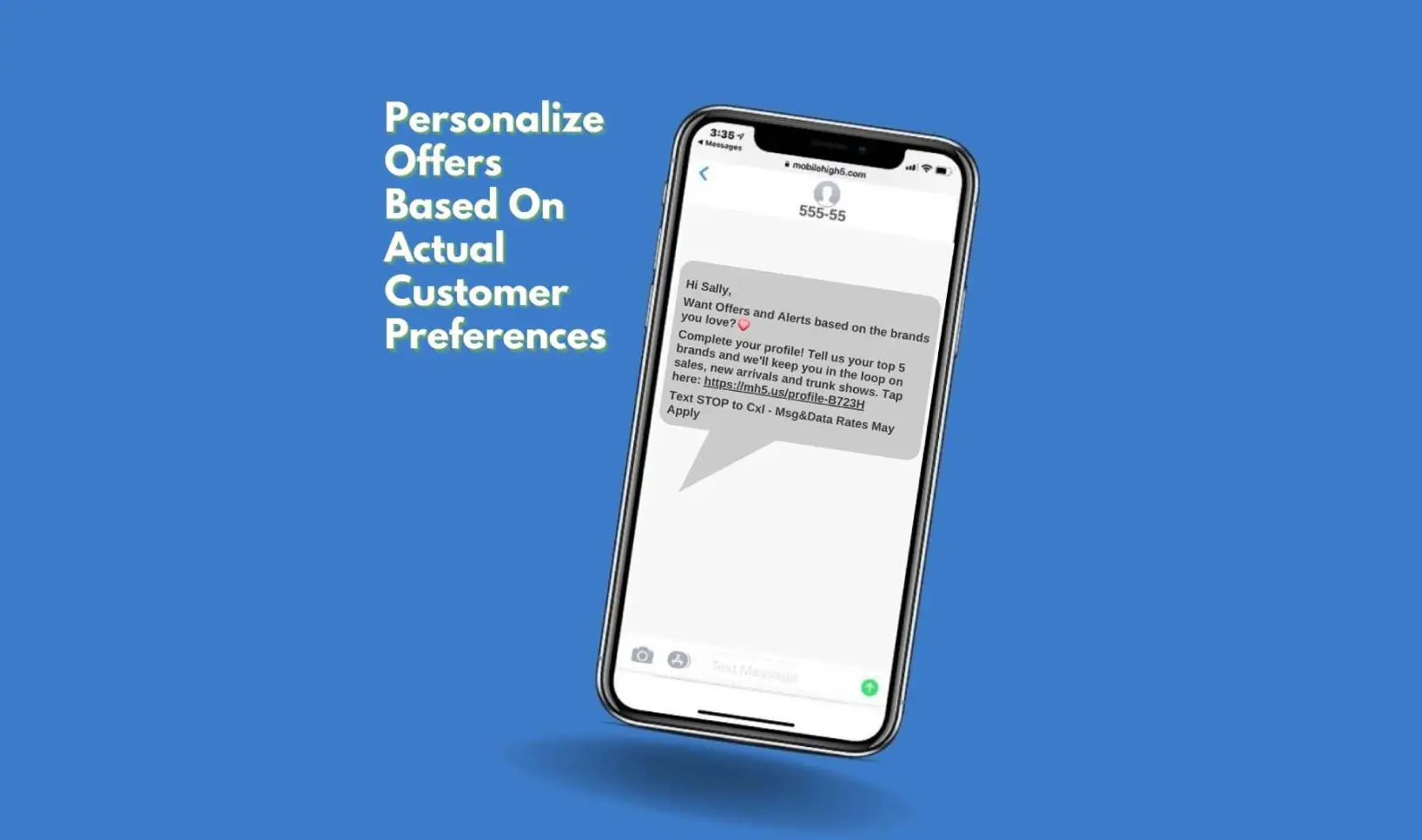
SMS keyword best practices
One of the most crucial text marketing campaign best practices is keyword selection. Be sure to use unique keywords that are easy to spell and memorable. Try to create a brand-related keyword that is immune to autocorrect issues.
An SMS keyword is a word consumers use to opt into a brand’s SMS program and use the shortcode corresponding to a specific SMS campaign. Keywords can be key to improving upselling and loyalty. For example, a 2021 report from eMarketer found that 50% of respondents would opt into loyalty programs if combined with an offer for coupons, deals, or flash sale notices.
Leverage these keyword best practices to make the most of SMS campaigns:
- Be memorable
“The keywords for SMS marketing must be unique and memorable,” advises Nazy Rafaeil, SEO and marketing director of Jovani, a dress wear manufacturer. “We prioritize using one keyword with four to seven characters, as it is easier for customers to remember. We avoid using special characters and use simpler keywords that the customers can easily memorize. Although it’s tempting to use overly unique words, provide customers with something they can easily remember without getting confused.”

Nazy Rafaeil, SEO and marketing director of Jovani.
- Keep it simple
The keyword should be something people see once and remember. - A single word is preferable
The shorter, the better. You can use more words, but they add a bit of complexity that may create problems, such as requiring additional space. Anything that slows down keyword input works against you. - Relate the keyword to your brand
Your keyword should be straightforward, and when possible, reflect your business and brand. For example, if you sell footwear, a keyword might be “SHOES” or “INSTEP.” - Avoid special characters
Forget ampersands and exclamation points. Subscribers may get frustrated and just give up instead of opting in. - Keep autocorrect in mind
Don’t make up words because they will likely be autocorrected to something else when your subscriber types it in.
SMS copy best practices
SMS marketing copy best practices are all about building your brand. Even with the restricted copy count of mobile marketing, you can make your point and get your message across to your customers. For example, emphasize essential words and phrases.
You already have a running start for text-based marketing simply because consumers like it. G2’s LearnHub reports that 70% of people feel text messages are one of the best ways to gain their mindshare. With well-crafted copy, you can motivate consumers and boost sales.
Here are the details of SMS copy best practices:
- Write concise copy to build your brand reputation
This advice comes from Gigi Ji, chief brand officer at KOKOLU, a 100% post-consumer recycled apparel company. “Even though people tend to like SMS marketing, perhaps more than any other channel, the copy must be concise, smart, and compliant,” she says.
“If you’ve determined that users are interested in hearing from you in this format, communicate information that is truly useful to them or even an offer or reward,” she says. “Have clarity around your opt-out process and make it easy to execute. Brands that overlook opt-in-and-out protocols get a bad spamming reputation. Use best practices to make your SMS marketing feel like a friendly communication rather than a company trying to sell something.”

Gigi Ji, chief brand officer at KOKOLU.
- Consider adding Multimedia Messaging Service (MMS)
MMS costs more to send than SMS messages. However, it may be an appropriate and reasonable bang for your buck to promote companies like restaurants or retailers who benefit from visuals and sound and allow you to use more characters than SMS to tell your story.
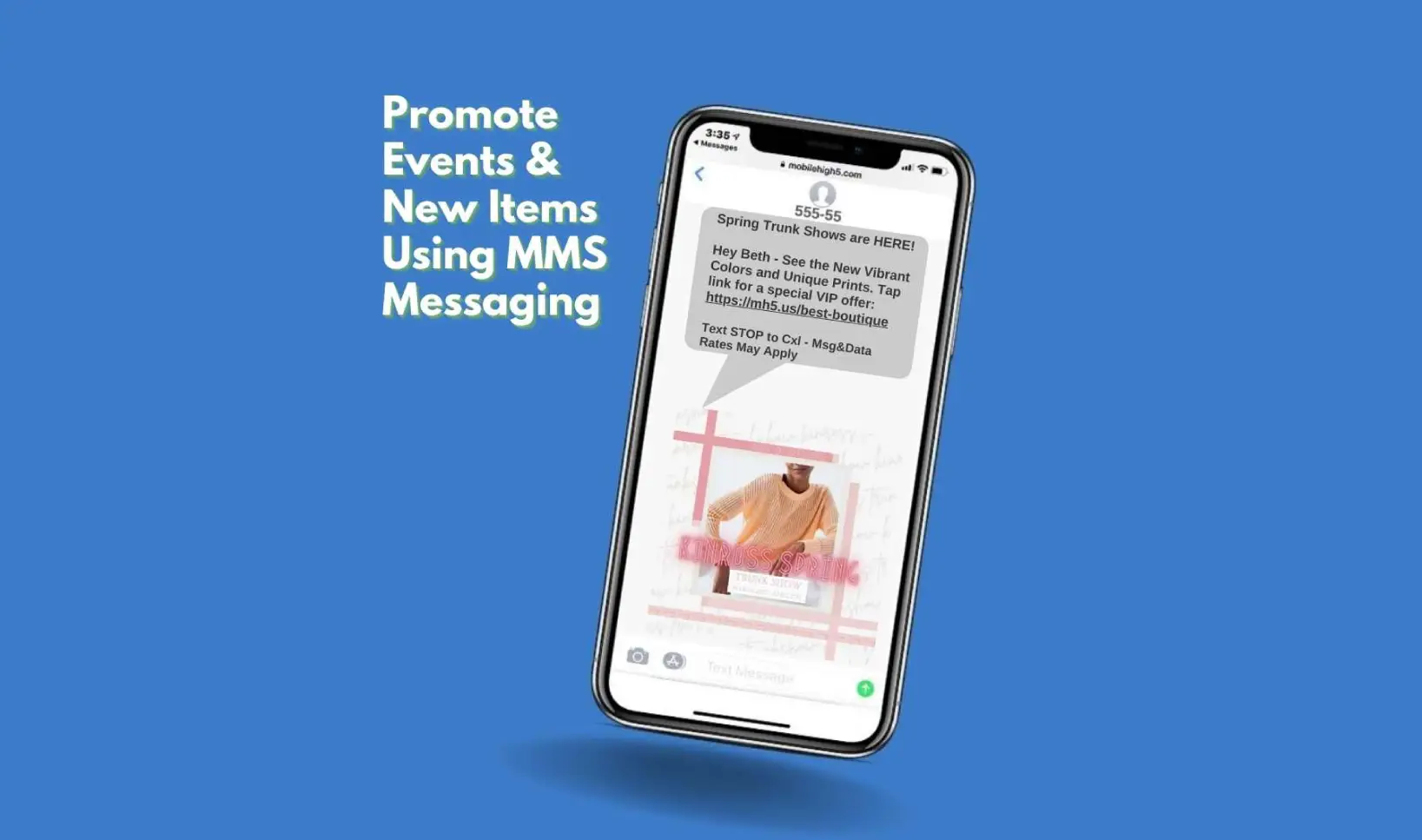
- Link to further information
Consumers engage with messages that link to more online information. Get recipients to relevant web pages to support your current offer or upsell. - Emphasize essential words
“One of our number one strategies to stand out is to highlight important words,” says Jovani’s Rafaeil. “For example, we emphasize words that attract customers like up to X% discount, free home delivery, and avail your voucher by XYZ date.” - Use “FREE” only if you mean it
When describing your text message programs, be aware of the word “FREE”. You cannot use the word “FREE” to entice customers to join your program unless the texts and program genuinely are free to the end-user (FTEU) with all supported carriers. You must use the phrase “Msg & data rates may apply” in any campaign that is not FTEU. - Check the rules one more time before you send
There may be areas that apply only to specific products. “For example, a little-known rule is that any marketing of CBD or cannabis products is prohibited on all messaging codes,” advises Mobile High 5’s Casey. “Even if those products are legal in your state, texting is a federal thing.” - Increase traffic with announcements
Use announcement texts to alert subscribers when you need to up your numbers for live events.
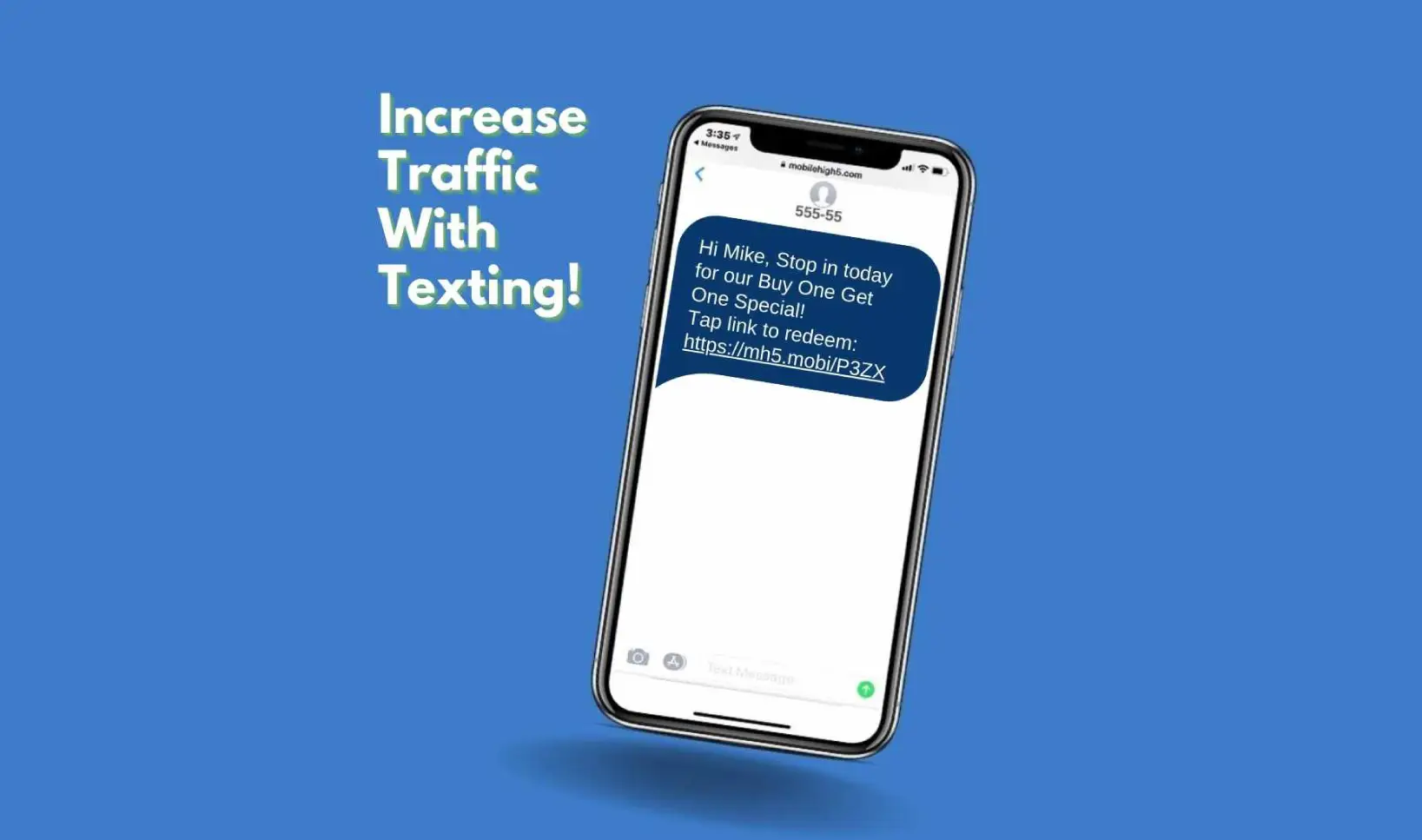
SMS short code best practices
SMS short code best practices make five to six digits memorable. Vanity short codes engage target audiences and are a best practice for brand and campaign building. The most important best practice is to follow CTIA rules to be legally compliant.
Here are three short code best practices:
- Use a short vanity code
Brands typically prefer a short vanity code that’s memorable for TV commercials or billboards. Vanity shortcodes are between five or six-digit numbers that spell something brand-related on a keypad, are fun to look at, like 007007, and have consecutive or repeating numbers. - Forget shared short codes
Thousands of brands in the past used the same short codes to send text marketing messages to their audiences, which made it hard to differentiate between senders and created a spam-riddled mobile landscape and low click-through rates. The major wireless carriers no longer allow shared short codes as of 2021. - Follow the CTIA short code rules
There’s an easy way to know how to handle short codes because everything you need to know is in the CTIA’s Short Code Monitoring Handbook. Violate the rules, and wireless carriers can deactivate the text messaging campaign.
SMS security best practices
SMS security best practices protect your customer data and privacy from breaches. These steps include using a secure text platform and SSL certificates. Without adequate security, hackers can download your customer’s mobile phone numbers or send an unauthorized message.
Data breaches are a brand disaster and expensive. According to IBM, the average cost of a data breach was over $4 million in 2021.
To prevent data breaches, follow these SMS security best practices:
- Take advantage of a secure text platform
A secure text messaging platform’s code has built-in safe SMS security. The platform should provide in-transit and storage encryption, preventing outside parties from hacking into business SMS platforms. - Enable Secure Sockets Layer (SSL) certificates
The only way to ensure that your mobile app is completely secure is to purchase an SSL certificate. This encryption method protects data and secures the connection between your customers and your web browser. These provide HTTPS and assure users that your mobile app is safe. The small green padlock visible on browser tabs indicates the presence of HTTPS. It promotes seamless connection and protects data from third parties, thereby avoiding data breaches, message forgery, and eavesdropping. - Set up your text platform with permissions
You can set user roles and permissions to control access to customer data for your staff.
SMS customer service best practices
SMS customer service best practices make clients happy because of fast, convenient service. You can use SMS for immediate customer support, working in tandem with channels such as phone calls or email. SMS also allows for easy follow-up with customers.
In a 2020 research study by Dimensional Research, 62% of the respondents preferred SMS as a customer service channel over voice interactions. Use SMS for customer service functions, order confirmations, dispatch notifications, appointment scheduling, tracking information, and deliveries. Customers are more likely to keep opting in when you provide valuable service and customer service and support.
Here are some additional customer service best practices:
- Tie in SMS and other channels for customer support
Different channels can play different roles in customer support. Make sure they work together well and serve different customer preferences. A well-planned service system increases customer satisfaction, saves time, and may lower your necessary staffing. - Resolve problems quickly
SMS enables your agents to troubleshoot immediately in live chats. This saves customers the trouble of being bounced around. It also gives you the benefit of faster resolution and happier customers. - Follow up
Even if the issue resolves, be sure to go the extra mile and follow up to make sure your customer is satisfied and find out if they need anything else.
SMS survey best practices
SMS survey best practices make it easy to get timely customer feedback. Well-designed, brief surveys provide valuable insights into customer habits and preferences. Be sure to include appreciation in your customer follow-up as well as special offers to improve engagement and loyalty.
Are surveys a good use of your time? Yes. Business.com reported in 2022 that over 30% of consumers respond to surveys via SMS and respond in less than six minutes.
Check out these SMS survey best practices:
- Ensure mobile-friendliness
Make it easy to respond. Customers must be able to open, get started, and finish quickly so they don’t abandon the activity before completion. - Use surveys judiciously
Resist the temptation to send a constant flow of surveys. Too many surveys can lead to customers opting out. - Use personalization
Use your customer’s first name, surveying based on what you know about them, and use their past interaction with your brand to inform your messaging. - Follow up
You can let your customer know you appreciate them and also reinforce the good feelings with a discount, VIP entry, or other special offers—and a big thank you.
Subscriber growth best practices
SMS subscriber list best practices begin with choosing the right SMS and short link providers. Use every online and offline touchpoint to engage with customers. Make enticing offers, use reviews as a signup tool, and take advantage of social media.
Building your subscriber list starts with asking customers to opt in and making it easy to sign up for your text messages. A 2021 Attentive Mobile Consumer Report found that 91% of customers are interested in signing up for texts, and over 50% said they already have.
Try these subscriber growth best practices to make your list flourish:
- Choose your SMS and short link services carefully
Check platform and software reviews. Compare features and ease of integration for possible SMS marketing services and link shortening partners. To improve SMS experiences overall for your audiences, select trustworthy providers with tools to help you grow your list of subscribers. Also, deliver campaigns at scale and have engagement as an automatic feature. Choose a link shortening service, like Bitly, with an excellent reliability record, speedy API, and support services to make your SMS marketing more effective. - Start small with a focus on quality
“To grow your subscriber list, my best advice for those new to SMS marketing would be to start small, focusing on quality over quantity,” says Kate Zhang, founder of Kate Backdrop.
“Build up a database of customers who have opted in to receive your messages, and then segment them according to their needs and interests. Be strategic and data-driven in your approach. Analyzing the success of various campaigns and constantly optimizing them based on this data will help you achieve better results in the long run and will grow your subscriber list. Overall, SMS marketing is a powerful tool for engaging and retaining customers.”

Kate Zhang, founder of Kate Backdrop.
- Maximize your website
Create landing pages to collect opt-ins. You can also use web popups, banners and prompts, and webchat with an embedded lead form. - Use point-of-sale or transaction options
Integrate opt-in points via SMS invoices, checkout carts, or point-of-sale systems. - Leverage reviews
Ask customers for their opinion, and then ask for their opt-in after submitting reviews. - Entice with URL and QR Codes
Link people with URLs that lead directly to signup forms. Don’t forget to include QR Codes on printed or digital signage for scanning and connecting to your signup form. - Make them an offer they can’t refuse
When you know your target audience, provide them with an offer based on who they are and any previous interactions with you via SMS or other purchasing activity. - Get social
Grow your list on non-owned channels like social media with keyword texting.
SMS re-engagement best practices
SMS re-engagement best practices are the pathways to customer retention. The best way to reconnect is to reach out at the right time, create a sense of urgency, and act on feedback. Use automation for effective and timely re-engagement campaigns.
As every marketer knows, you need to hang on to your customers to make your business thrive. 2020 research from Invesp confirms that loyal customers are worth ten times more than their first purchase’s value.
These SMS re-engagement best practices will put you back in contact with customers whose attention is flagging:
- Watch your timing
Timing, like with everything, is critical, and sending a text too early or too late can have negative effects, especially when trying to re-engage customers,” emphasizes Devon Fata, CEO of Pixoul, a digital product design consultancy and staffing firm. “Because the open rate is so close to 100% with SMS marketing, be mindful of when you’re sending your SMS messages. Aim for the middle of the day when your customers will be more receptive to opening the messages, thus increasing your success rate.”

Devon Fata, CEO of Pixoul.
- Come back strong with a call to action
“For customer re-engagement, I use a powerful CTA,” says Rodney Warner, CEO and business development manager of Connective Web Design. “Your CTA can be the key to getting a sale instead of ignoring your text.”

Rodney Warner, CEO of Connective Web Design.
- Create a sense of urgency
“For customer re-engagement, use effective call to action buttons and clickable content,” recommends Jovani’s Rafaeil. “Creating a sense of urgency in customers through CTAs and clickable content increases customer engagement. For example, ‘Last two days to avail of the offer, click here!’” - Keep on sharing
Reach out to customers you know are slipping away. Find out what’s wrong. You might provide tips about the product or gather feedback for future product development. - Act on customer feedback
Above all, listen to what they have to say and act on it. - Use alerts to follow up on cancellations
You can automate cancellation alerts. Ask if you could have done anything differently. You may win them the customer back, get valuable insights into how to keep customers happy, or both. - Automate to stay in touch no matter how busy you are
Automation makes the most of your resources, scales your strategy, and improves retention. Send automated messages to users who have low or no activity based on time frames—for example, 30, 60, or 90 days—and create a message to stimulate a response based on past purchases or interactions, and then use an automation service.
Best practices to increase SMS marketing engagement
The best practices to increase SMS marketing engagement revolve around collecting, segmenting, and using customer data. Leveraging customer analytics insights into what customers want makes crafting effective campaigns much easier.
Companies that intensively use customer analytics are 2.6 times more likely to have a significantly higher ROI than competitors, according to research firm McKinsey.
Bitly’s Harbour echoes McKinsey’s findings. “The popularity of branded short links is growing quickly,” says Harbour. “We’ve seen over 10% growth from 2021 to 2022. Branded short links reduce SMS costs and increase CTR. Marketers also benefit from interactive campaign management and comprehensive data and analytics.”
Use Bitly branded short links to power your SMS
Bitly’s powerful API creates thousands of unique SMS communications. Create appointment reminders, fundraising requests, and customer support updates. You can also generate location-based promotions, order statuses, and service delays or changes using branded short links.
Since they’re short links, you will save on SMS per-character fees, too. Branded links are highly effective trust builders because they reveal what the link is for and who is behind it, leading to higher open rates and click-through rates.
Beyond that, Bitly’s tracking metrics monitor the performance and effectiveness of branded links. In addition to improved CTR, Bitly’s analytics measure demographic, location, and other metrics. You can then use the insights gained to refine and improve your campaign more than you could with CTR alone. Another way to save is with bulk SMS. Bitly’s management platform is designed for large volumes and scale as your SMS campaigns power up.
Thanks for confirming your email.